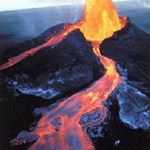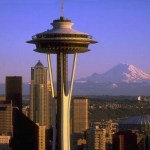Volcanology
The science of cartography has come a long way over the centuries, from the caricatured coastlines of antiquity to the highly-detailed satellite images of today. We know our terrestrial boundaries very well, and until all the polar ice melts and raises sea levels, mapmakers are busy looking elsewhere. Greg Laden explores the magma chamber beneath Yellowstone, which was modelled by observing the transmission of shock waves through the earth's crust. Greg explains, "This sonar-like approach allows the mapping of underground three-dimensional structure," and he has the pictures to prove it…
Back at the height of volcano-mania, I wrote that "Eyjafjallajökull's ill temper been an unexpected object lesson in the complexity and interconnectedness of our environment, technology, and social networks." Jason Goldman of The Thoughtful Animal added further dimensions in his post Intelligence, Cancer, and Eyjafjallajökull. But why stop there?
Taking up that torch is Lee Billings, longtime Seed Magazine editor, expert of all things exo- and heir to my "Week in Review" column. In this week edition, Ashes to Ashes, he's fleshed out the ways that Eyjafjallajökull demonstrates the "fragile…
Though airplanes are starting to take off from various parts of continental Europe, UK airspace will remain locked down for at least another day. Eyjafjallajökull's ill temper has been an unexpected object lesson in the complexity and interconnectedness of our environment, technology, and social networks. Who knew that you needed to factor glaciology and geophysics into of whether hotel rooms would be booked for a day or a week? Or whether President Obama could attend his Polish counterpart's state funeral? The same phenomenon has deprived Dr. Isis' hospital of the technetium it needs in its…
Generally, it takes the threat of imminent death or disaster to get earth science onto the front page of newspapers, and today is no exception. A massive plume of ash emanating from the tongue-twisting Eyjafjallajökull eruption in Iceland has thrown a wrench into much of Europe's travel plans; the silicate particles in the ash can melt in jet engines and cause them to stall. Fortunately, resident geologist and volcano buff Erik Klemetti has been covering Eyjafjallajökull's activity since it began almost a month ago. The cloud of ash seems poised to stick around all day, so if you're stuck…
Erik Klemetti on Eruptions solicits your suggestions for the titular honor:
2009 is almost over and it has been quite a busy year, volcanically speaking. This is not to say that is was anomalously volcanic - more that many of the volcanic events captured the media's attention. I'll be putting together a "Volcanic Year in Review" for 2009 and at the end I'll award the 2009 "Volcanic Event of the Year" (a Pliny?) ... but now its your turn to nominate events for the award.
Suitable entries include "eruptions, signs of an eruption, a big research article, a media debacle/success" or just about…
When it comes to geologic phenomena, the difference between renewal and cataclysm can walk a fine line. On All of My Faults Are Stress Related, Kim Hannula elucidates the distinction between causes and triggers. Citing an article about the Zipingpu Dam that concludes that the weight of the reservoir might have triggered an earthquake, Hannula notes that "the ultimate cause of the earthquake was the collision of India with Asia, and the resultant tectonic mess." Elsewhere, Erik Klemetti on Eruptions dresses down Popular Science alarmism, concluding that the chance of exploratory drilling…
As the Earth's tectonic plates shift and grind miles below our feet, we feel the effects on the surface in the form of earthquakes and volcanic activity. As Ed Yong of Not Exactly Rocket Science and Chris Rowan of Highly Allochthonous explain, earthquakes far from tectonic plate boundaries may be aftershocks of more violent seismic events along mid-continental faults that occurred hundreds of years earlier. According to a study published in Nature this week, faults in the middle of a continent take much longer—100 years or more—to return to normal activity; thus, aftershocks can occur long…
This week, Eruptions' Erik Klemetti sparked interest in the recent rumblings heard coming from Mt. Rainier in Washington State when he responded to a reader's comment on increased seismic activity in the area over the past month. Klemetti's response post, which reported on concrete facts surrounding the geologic events and featured a detailed graph of Mt. Rainier's seismic activity over the past year, yielded a slew of comments and stirred fellow blogger, Greg Laden, to post a related story, which also garnered lively commentary. Ironically, Klemetti's following post detailed this viral…

